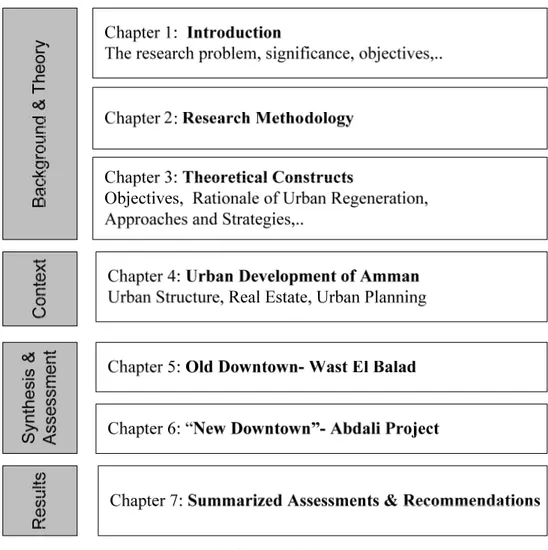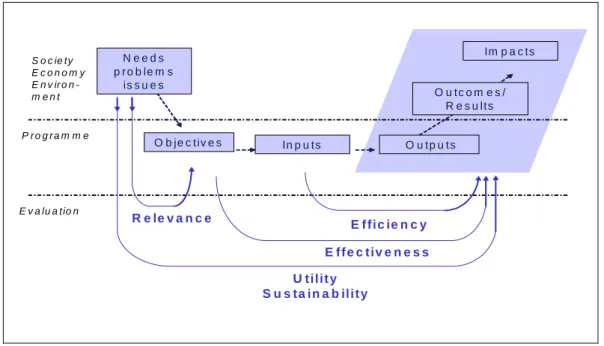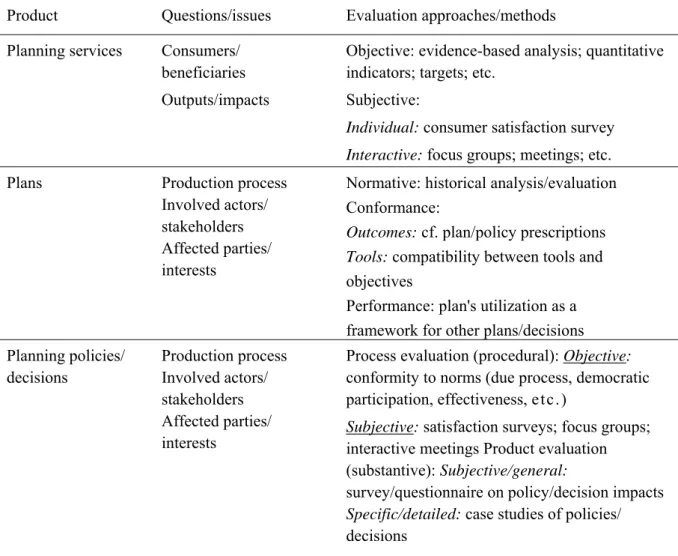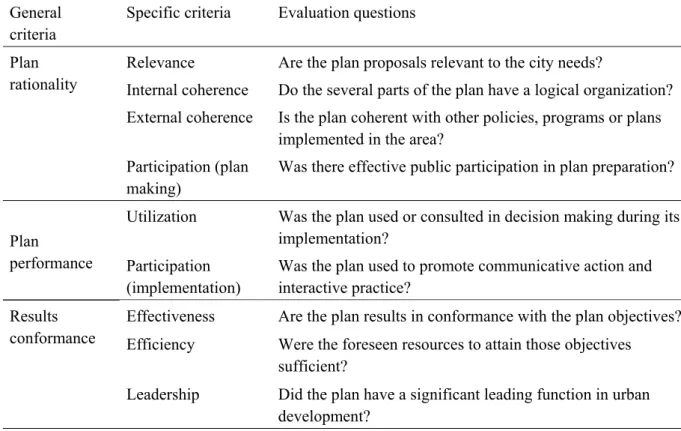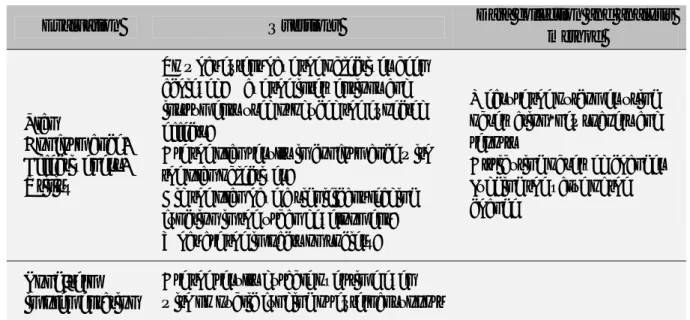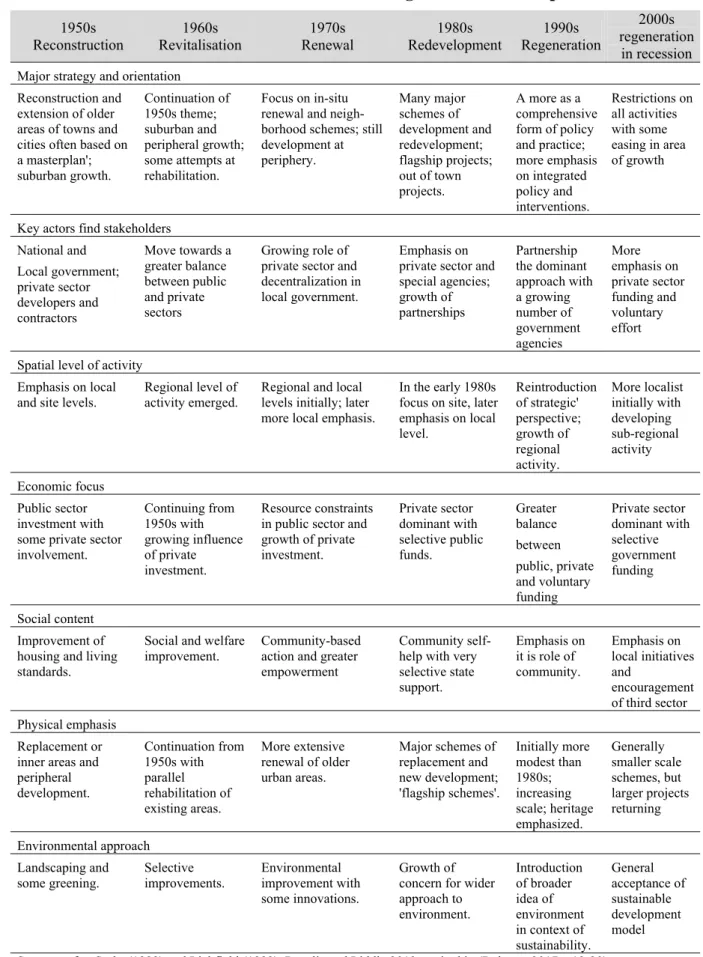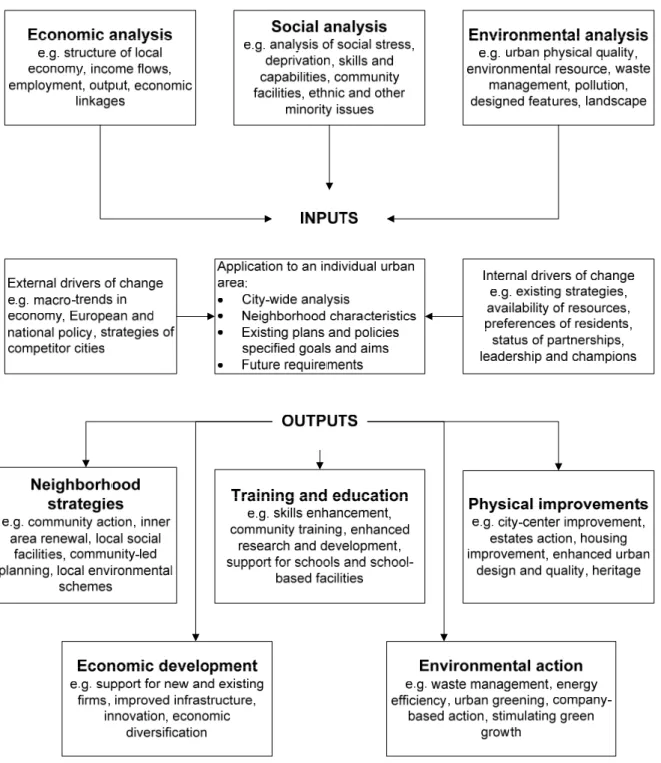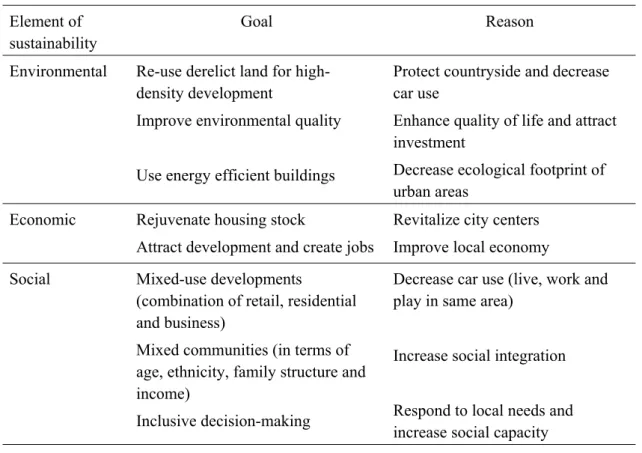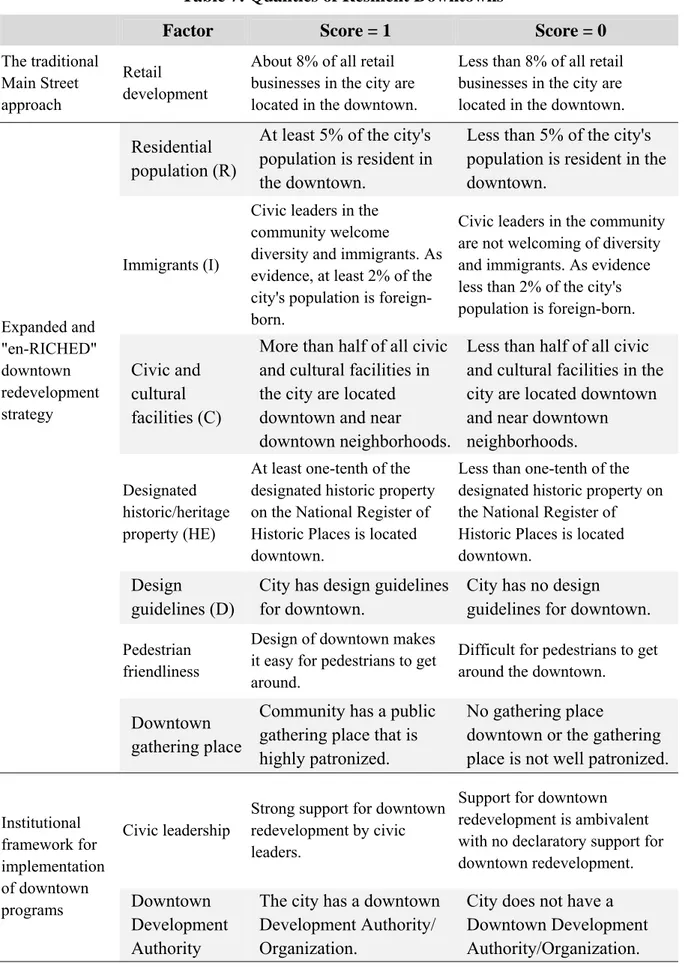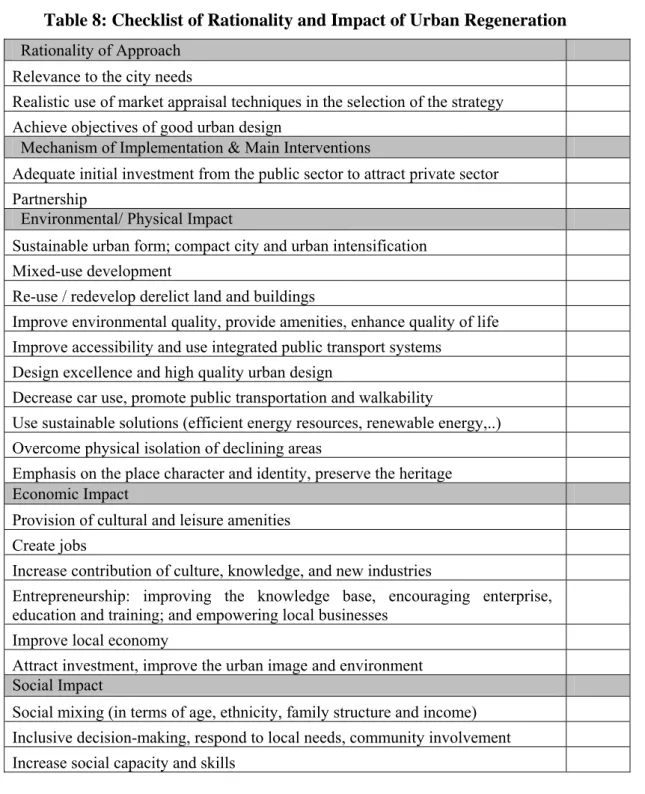Urban Regeneration Strategies in Amman’s Core:
Urban Development and Real Estate Market
By
Kamila Naim Ashour
Thesis submitted to the Faculty of Spatial Planning at Dortmund Technical University
for the award of the degree of Dr. Ing
.
Prof. Dr. Christoph Zöpel, TU Dortmund Prof. Christa Reicher, TU Dortmund Dr. Mehdi Vazifedoost, TU Dortmund
December 2016
Dortmund/ Amman
DECL I hereb academ presen
LARATION by declare t mic rules an nted in the re N
that all info nd ethical m esearch are
ormation in manner. I a
my origina
this researc also declare al research w
ch has been e that the a work.
n presented analysis, sy
Kam
in accordan ynthesis and
mila Naim Decembe
nce with d results
Ashour er, 2016
2 ACKNOWLEDGEMENT
I would like to express my sincere gratitude to Prof. Dr. Christoph Zöpel and Prof. Christa Reicher for their supervision, guidance and encouragement. The research was a journey with their company that has enriched my experiences and polished my approach in analysis and critics. I would like to thank also Dr. Mehdi Vazifedoost who took on the role of examinar.
Thanks to my friends and the people who facilitate my access to data and information.
Thanks to my family who has been incredibly supportive during my study with wonderful encouragement and understanding.
ABSTRACT
Little knowledge about urban regeneration in the Middle East has been explored. Showing experiences in the case of Amman would contribute to the theory building of urban regeneration. The following research is an assessment of urban regeneration policies and experiences in Amman’s core in two cases: the Old Downtown, Wast El-Balad, and the
“New Downtown”, Abdali. The experiences are critically assessed using both qualitative and quantitative methods. The analysis and review are conducted based on data from onsite, interviews, observations, photographs, official reports and articles. Findings from literature provided a framework of principles of good urban regeneration policies, and organized the research questions and structure. The assessment concerns rationality, impact, effectiveness and the long-term implementation of urban policies. Many proposals and projects for revitalizing Wast El-Balad were completed. Most of the implemented projects were financed by grants. There was no commitment to the proposed urban policies and regulations, thus the Downtown heritage is at risk. Abdali was developed by an organization, most of Phase I is constructed, but Phase II is not. This research examines the role of urban planning, real estate markets and urban regeneration policies in providing the desired outcomes. Urban regeneration was proposed and implemented in the absence of realistic appraisal of the market conditions. Some urban policies of the future plans of Amman would have a bad impact on the city’s development. Although the initial intentions of urban regeneration were economic development, the outcomes end up with physical improvements but put off the key economic drivers, thus, causing the beautification of the container and the loss of the content.
Abdali is developed at a central location between “East Amman” and “West Amman”.
Abdali’s development would rebalance and relocate the center of gravity of the city towards the core. Abdali has an important influence on re-locating the city center to the core of Amman. There are many challenges facing the success of Abdali and Wast El-Balad.
Spatially, Abdali’s development is rational, but the supply of commercial spaces exceeds the local demand. The Abdali trade market is linked to external players, investors and users.
Abdali, a new large scale development has a high vacancy rate, requires revitalization!
Decisions on the national level to improve the local economy are a productive way to reduce the failure of the real estate market. A lot of work should be done to solve the urban problems of Wast El-Balad. Abdali and Wast El-Balad together would function as two poles
4
tying and binding central Amman. This connection with Shmesani composes the central business district of Amman.
Research on urban regeneration about cases in Jordan done in the context of spatial sciences in Germany, combines two different scientific backgrounds and interests. Spatial sciences in Jordan are very recent compared to long traditions in Germany. Under these circumstances, scientific interests in both Jordan and Germany should be considered and respected. German interest may deal with the importance of spatial and urban development in Jordan for global development. The Jordanian interest may include developing an understanding of urban regeneration through assessing the local urban development policies and practices, and learning general principles of good practice and experiences from better-developed regions of the World like Europe and the US.
CONTENTS
ACKNOWLEDGEMENT ... 2
ABSTRACT ... 3
List of Figures ... 10
List of Tables ... 12
1. INTRODUCTION ... 14
1.1 Background ... 14
1.2 Research Problem ... 15
1.3 Research Objectives ... 16
1.4 Research Questions ... 16
1.5 Limited information of Research ... 17
1.6 Research Organization ... 17
2. METHODOLOGY AND DATA ANALYSIS METHODS ... 19
2.1 Research Approach ... 21
2.2 Research Design ... 21
2.3 Data Collection Method ... 27
2.4 Data Analysis Strategy ... 28
3. THEORETICAL CONSTRUCTS: OVERVIEW OF URBAN REGENERATION APPROACHES ... 29
3.1 Definitions, Objectives and Rationale of Urban Regeneration ... 30
3.2 Characteristics of Successful Urban Regeneration ... 38
3.3 Approaches and Strategies of Urban Regeneration ... 43
6
3.3.2 Social and Cultural Approach ... 48
3.3.3 Sustainable Urban Regeneration ... 51
3.4 Approaches and Strategies for Downtown Revitalization ... 53
3.4.1 Emphasis on the Place Character and Quality ... 54
3.4.2 Mixed Use Development ... 55
3.4.3 The Main Street approach ... 58
3.4.4 Resilient downtowns ... 59
3.4.5 Walkable urbanism ... 62
3.4.6 Pedestrian friendly environment ... 64
3.5 Mechanism ... 64
3.6 Summary ... 69
3.6.1 Principles and Approaches for Urban Regeneration ... 69
3.6.2 Strategies for Downtown Revitalisation ... 72
4. AMMAN URBAN DEVELOPMENT AND URBAN PLANNING ... 74
4.1 Amman’s Urban Structure ... 74
4.1.1 Physical Dimension ... 74
4.1.2 Social and Cultural Dimensions ... 83
4.2 Urban Planning in Amman ... 89
4.2.1 The 1987 Greater Amman Comprehensive Plan ... 90
4.2.2 The Metropolitan Growth Plan (MGP) ... 93
4.2.3 Experiences of Urban Regeneration ... 100
4.3 Economic Development and the impact of urban planning ... 107
4.4 The Real Estate Market ... 113
4.4.1 Retail……… ... 113
4.4.2 Offices……….. ... 117
4.4.3 Hotels……….. ... 119
4.4.4 Housing…….. ... 123
4.5 Key Issues ... 123
5. THE AMMAN OLD DOWNTOWN ... 126
5.1 The Amman Downtown Development in the GACP, 1988 ... 127
5.1.1 Objectives and Policy ... 127
5.2 Amman Downtown Tourism Studies ... 132
5.2.1 The study on the Tourism Development Plan, 1996 ... 132
5.2.2 Amman Downtown Tourist Zone Sub-project, 2000 ... 136
5.3 The Amman Downtown Plan and Revitalization Strategy 2010 ... 139
5.3.1 Goals and Objectives ... 141
5.3.2 The Urban Revitalization Approach ... 142
5.4 The Urban Strip- The Wadi Amman Project ... 146
5.4.1 Goals and Objectives ... 146
5.4.2 Approach, Strategy and Policy ... 146
5.4.3 Implementation ... 150
5.5 The Cultural Strip ... 151
5.6 Assessment ... 153
5.6.1 The Downtown planning Approaches ... 153
5.6.2 The Economy and the Real Estate Market Development Impact ... 157
5.6.3 The Physical and Environmental Impact ... 170
5.6.4 The Social Impact ... 198
5.6.5 Factors contributing to the decline of downtown Amman ... 199
5.7 Summary ... 208
5.7.1 Challenges and Potentials of the Downtown ... 208
5.7.2 Rationality and Impact ... 209
5.7.3 Plan Conformance and Effectiveness ... 212
5.7.4 Long-Term Implementation ... 214
6. THE ABDALI PROJECT – “NEW DOWNTOWN” ... 215
6.1 Urban development of Abdali since 1980s ... 215
6.2 Goals of the Abdali project ... 220
6.3 Assessment ... 224
6.3.1 The Development Approach ... 224
6.3.2 The Real Estate Market Development and the Economic Impact ... 227
8
6.4 Summary ... 259
6.4.1 Challenges and Opportunities of Abdali ... 259
6.4.2 Rationality and Impact of Abdali’s Urban Policy ... 260
6.4.3 Urban Policy Conformance/Effectiveness ... 263
6.4.4 Long Term Implementation ... 263
7. SUMMARIZED ASSESSMENTS AND RECOMMENDATIONS ... 264
7.1 Summarized Assessments ... 265
7.1.1 Challenges for the Success of the Urban Regeneration of “Downtowns” ... 265
7.1.2 Urban Regeneration Approaches ... 266
7.2 Recommendations ... 274
7.2.1 Strengthen the core of Amman ... 274
7.2.2 Improve the local economy ... 275
7.2.3 Link the “New Downtown” Abdali with the Old Downtown ... 276
7.2.4 Strengthen the Old Downtown ... 276
7.2.5 Improve the New Downtown Abdali ... 282
7.2.6 Capacity building and strengthening the municipality role ... 283
7.3 General implications for urban regeneration development ... 284
7.4 Further Research ... 285
8. APPENDIX 1: THE AMMAN DOWNTOWN PLAN AND REVITALIZATION STRATEGY, 2010 ... 286
8.1 Long Term Development Framework ... 289
8.1.1 Land use……. ... 289
8.1.2 Transport and Transit ... 295
8.1.3 Heritage……. ... 297
8.1.4 Public Realm.. ... 298
8.1.5 Infrastructure... 301
8.1.6 Urban Form.. ... 301
8.2 Regulatory Framework ... 302
8.3 Key Projects and Interventions ... 304
8.3.1 Public Projects ... 304
8.3.2 Social and Economic Development Projects ... 314
8.3.3 Pilot interventions ... 318 8.4 Community Engagement ... 319 9 BIBLIOGRAPHY ... 320
10 List of Figures
Figure 1: the Amman Downtowns ... 14
Figure 2: The Study Area ... 15
Figure 3: Research Structure ... 18
Figure 4: Types of Methodologies ... 19
Figure 5: Ex-ante evaluation criteria ... 23
Figure 6: The research design ... 26
Figure 8: Classification of the urban intervention terms ... 32
Figure 9: Homogenization of the different urban intervention terms ... 32
Figure 10: The Urban Regeneration Process ... 35
Figure 11: Process of Urban Revitalization/Regeneration ... 73
Figure 12: An aerial photograph of Amman in 1918 ... 75
Figure 13: An aerial photograph of Amman in 1953 ... 75
Figure 14: Amman in 1930s ... 76
Figure 15: Seil Amman in 1953 ... 77
Figure 17: Amman's Growth Pattern (1946-2005) ... 79
Figure 19: GAM’s boundary and Zoning in 2015 ... 81
Figure 20: The Urban Spatial Structure of Amman ... 82
Figure 23: GAM's Boundary ... 89
Figure 25: Amman Plan, 1989 ... 91
Figure 26: The Amman CBD ... 92
Figure 27: Metropolitan Growth Plan (2005-2025) ... 95
Figure 29: Amman Development Corridor Strategic Master Plan ... 99
Figure 30: Proposals of conceptual developments in East Amman ... 100
Figure 31: Jordan GDP (JD) per Capita ... 110
Figure 33: Contribution of economic sectors to GDP in 2014 ... 111
Figure 34: Greater Amman Municipality Districts ... 116
Figure 35: Chart of Tourist Statistics in Jordan, in Millions ... 120
Figure 36: The City Center of Amman ... 124
Figure 37: The Downtown Boundary ... 126
Figure 38: The Immediate Actions Proposals ... 129
Figure 39: Roman Forum Restoration ... 130
Figure 40: King Faisal Square Improvements ... 130
Figure 42: Longer Term Proposals ... 131
Figure 43: Amman Downtown Tourist Zone Project Components ... 133
Figure 44: Upgrading Raghadan Terminal ... 134
Figure 45: Amman Downtown Tourist Zone ... 138
Figure 46: Layout Map of the Tourist Street (the King Talal Street) ... 139
Figure 48: Amman Downtown Area ... 140
Figure 49: Strategy for the Downtown Revitalization ... 142
Figure 51: Designation of zoning and heights ... 149
Figure 52: The Center of Performing Art, by Zaha Hadid ... 152
Figure 53: Specialized Markets ... 155
Figure 55: Proposal of a regional terminal at the North Terminal ... 165
Figure 57: ADPRS -Building Height Proposal ... 173
Figure 58: ADPRS- Large scale development Proposal ... 173
Figure 59: Public Realm Strategy ... 182
Figure 60: bad conditions of sidewalks ... 187
Figure 61: The Downtown Gateways ... 189
Figure 62: Conceptual Land Use ... 190
Figure 63: Existing parking lots ... 194
Figure 64: Malls Distribution in Amman ... 203
Figure 65: Amman Urban Morphology and Approximate Division Line between East and West Amman ... 204
Figure 66: Photos of the neighborhood surrounding the Downtown ... 205
Figure 67: Proposed Major Projects in 2009 ... 206
Figure 68: Dispersed Economic Activities ... 207
Figure 69: Proposal of the Amman CBD in 1989 ... 215
Figure 70: The Abdali Master Plan ... 216
Figure 71: Abdali -Location ... 218
Figure 72: Main institutions and facilities around Abdali ... 219
Figure 75: Models of Abdali ... 229
Figure 76: Layout of the master plan sectors ... 230
Figure 77: Amman- Land Use Plan ... 232
Figure 79: Abdali's Completion Status ... 239
Figure 80: Abdali's Developers Key Map ... 243
Figure 81: Forest was at Abdali before construction ... 248
Figure 83: The Downtown Urban Revitalization Process ... 272
Figure 84: The Abdali Urban Regeneration Process ... 273
Figure 85: Amman Downtown Special Planning Area ... 289
Figure 86: Conceptual Land Use – Emphasis ... 290
Figure 87: Mixed Use Strategy ... 291
Figure 88: Higher Order Public Transit- Proposed Phasing ... 297
Figure 89: Downtown Cultural Heritage Zone ... 298
Figure 90: Public Realm Strategy ... 299
Figure 91: Pedestrian Friendly Network ... 300
Figure 92: Existing Built Form ... 301
Figure 94: Sidewalks Enhancement ... 304
Figure 96: Shared and Managed Streets ... 306
Figure 98: The Maydan Amman Project ... 308
Figure 99: An image of the envisioned open space ... 309
Figure 100: The Hashemite Plaza Proposal ... 310
Figure 101: Citadel Open Space Project ... 311
Figure 102: Southern West Gateway ... 312
Figure 103: Northern West Gateway ... 312
Figure 104: Eastern Gateway ... 313
Figure 105: Suggested locations for affordable housing program ... 315
Figure 106: Suggested Expansion of Theme Markets at Al-Husseini Mosque District ... 316
Figure 108: Locations of existing hotels and Antiquities sites in the Downtown ... 317
List of Tables
Table 1: Planning products and evaluation approaches/methods ... 24
Table 2: Plan's evaluation questions and criteria ... 25
Table 3: Evaluation Criteria ... 25
Table 4: The evolution of urban regeneration in Europe ... 34
Table 5: Outward-looking policies ... 51
Table 6: Key Elements of Sustainable Regeneration ... 52
Table 7: Qualities of Resilient Downtowns ... 61
Table 8: Checklist of Rationality and Impact of Urban Regeneration ... 70
Table 9: Principles and Characteristics of Urban Regeneration ... 71
Table 11: GAM Population 1900 – 2015 ... 83
Table 12: Amman growth by age group ... 84
Table 13: Expansion of GAM's boundary ... 89
Table 15: Sector Employment of Amman and Jordan-2008... 111
Table 16: Construction Permits in Jordan ... 112
Table 17: Total Built-up Commercial Space per District in sqm ... 115
Table 19: No. of Hotel, Apartments Distributed by Classification in Amman 2006 -2015 . 121 Table 20: Hotel Occupancy Rate in Amman by classification ... 121
Table 21: Occupancy Rate in Jordan by classification ... 122
Table 22: Beds Night / Arrivals at Hotels by Country ... 122
Table 24: Supply of Real Estate Properties ... 125
Table 25: Amman’s Downtown Revitalization Strategies... 154
Table 28: ADPRS- physical and environmental quality ... 197
Table 29: Indicators of Downtown Amman Decline... 199
Table 27: Downtown- Rationality and Impact of Urban Regeneration ... 210
Table 28: Changes of the Abdali land uses built up areas ... 232
Table 29: Rent Prices of offices ... 236
Table 30: Hotel cost per night ... 237
Table 31: Summary of the status of the Abdali development ... 239
Table 32: Status of the Abdali development projects ... 240
Table 33: Key Market Drivers ... 244
Table 34: Abdali- physical and environmental quality... 256
Table 35: Abdali- Rationality and Impact of Urban Regeneration ... 262
Table 36: Evaluation of the urban regeneration policy ... 269
Table 37: Checklist of Rationality and Impact of Urban Regeneration ... 270
ABBREVIATIONS
ADPRS: The Amman Downtown Plan and Revitalization Strategy BID: Business Improvement Districts
CEO: Chief Executive Officer FDI: Foreign Direct Investment
DoA: The Department of Antiquities of Jordan GACP: Greater Amman Comprehensive Plan 1987 GAM: The Greater Amman Municipality
JD: Jordanian Dinars
MoTA: Ministry of Tourism and Antiquities
MAWARED: the National Resources and Development Corporation MGP: Metropolitan Growth Plan
UNHCR: United Nations High Commissioner for Refugees UNRWA: United Nations Relief and Works Agency for Palestine USAID: United States Agency for International Development
1. INT
1.1 B Urban dynam seek to time. U approa redeve going regene Abdali
TRODUC
Background regeneratio mic policies
o develop a Urban regen ach and th elopments o on in Am eration in A
i Urban Reg
Abdali
TION
d
on experien responding a better futu
neration pol he increme on a large s mman, why Amman’s co generation P
F i
nces are bec to changes re while tac licies in Jor ental appro
scale in ma y and how ore: the Old Project (Abd
Figure 1: th
14 coming imp
in differen ckling urban rdan are ba oach. Amm any location w. The Res d Downtown dali) (Figur
he Amman Wast
4
portant wor t aspects of n problems sed on a m man is und
ns. The rese search focu n Wast El-B re 1&2).
n Downtown El-Balad
rldwide. Urb f life. Nation and challen ixed approa dergoing tr
earch aims uses on tw Balad and th
ns
rban regene ns around th
nges that ar ach of the b ransformatio to analyze wo cases o
he New Do
ration is he world rise over blueprint ons and
what is of urban owntown
1.2 Sign The re downto it cont the ca second local a
1.2 R The re in the
Source nificance of esearch rev own and the tributes to f ase of Amm
d, it provide authorities, a
Research P esearch conc
core of Am
: based on t f Research views urban
e Abdali pro filling a gap man, which es recomme and so contr
roblem cern is to e mman. Some
Figure the Amman
n regenera oject. The s p in knowle h would co endations to ributes to pr
evaluate the e proposals
e 2: The Stu n Plan Metro
ation case significance edge about ontribute to o enhance u roblem ana
e proposed a s are partial
udy Area opolitan Gro
studies in e of the rese
urban regen o theory bu
rban policie lysis and so
and ongoin lly impleme
owth, GAM
Amman’s arch has tw neration in uilding of u es and decis olving.
g redevelop ented, as in
M (2008)
core: the wo dimensio the Middle urban regen sion making
pment inter the case of
Amman ons: first, e East in neration;
g for the
rventions f the old
16
downtown, Wast El-Balad, where some projects were implemented, but other proposals of projects are not. The examined proposals for Wast El-Balad, the old downtown, were prepared through a draft study “The Amman Downtown Plan and Revitalization Strategy”
(ADPRS) by the Amman Institute1, in addition to proposals for the Urban Strip and the Cultural Strip in the downtown area.
Public and different private interests are influencing city development and transformation through constructing large urban projects, as in the case of the Abdali Urban Regeneration Project (Abdali). These developments are becoming an important phenomenon that require scholars to answer questions about what policies are suitable for the local context, as well as how and why they approach problems a certain way. The research findings are important to improve decision making in urban policy that has an impact on city development and society in Jordan, in the Middle East and on a common worldwide understanding of the issue.
1.3 Research Objectives
The research aims to achieve the following objectives:
To provide detailed information on the approaches of urban regeneration in Amman.
To assess the policies and achievements of these developments.
To propose guidelines for the improvement of urban regeneration in Amman.
1.4 Research Questions
The research is guided by the following questions:
Generally:
What are the principles of good urban regeneration policy?
What are the approaches of urban regeneration?
1 Amman Institute was a not-for-profit institution established by GAM in 2008, was responsible for preparing the Amman Metropolitan Plan 2025, in addition to working on urban good governance at national levels, addressing issues such as land management, planning, public policy, and civic leadership, development, and others. It was closed in late of 2011.
What are the approaches of downtown revitalization?
Concretely:
What are the urban regeneration policies in Amman’s downtown?
Do the policies represent an appropriate strategy to meet the city’s development needs?
How will policies contribute to the achievement of the objectives?
Are implementation mechanisms appropriate to achieve the objectives?
What was done and what has been achieved?
What will be the impact of the policies?
1.5 Limited information of Research The following are limitations to the research:
Data collection of official reports and information is difficult, and some data is considered confidential.
The Amman Institute that developed the studies and proposals is closed, which could have effect on data collection and analysis.
Information and data about the urban development of Amman are limited.
The urban policy of ADPRS regarding the old downtown has been partially implemented, the proposals are draft, and few projects were executed.
The Abdali project “New downtown” is partially implemented, most of phase I is executed, some are under construction, and others are on hold, while no project of phase II is implemented.
1.6 Research Organization
The research is organized in seven chapters (Figure 3): Chapter one is an introduction for the research problem, questions and objectives. Chapter two addresses the research methodology, clarifying the data collection and analysis methods. The research design focuses on case study research. The research is an assessment based on theoretical themes
18
framework of the research and explores urban regeneration approaches and strategies. The purpose of this chapter is to identify characteristics of successful urban regeneration, and a criterion of evaluation. The criterion will guide the assessment of the case studies. Chapter four describes the context of the urban development of Amman. The context describes what factors influenced Amman’s development and growth. It explores the urban planning policy of GAM through the master plans of 1987 and 2008. Chapter five and six show the two cases of urban regeneration – the old and new downtowns of Amman – presenting the urban regeneration policy and addressing the issues and problems to be considered. The case studies of approaches and strategies of urban regeneration are critically assessed. Chapter seven summarizes the research findings, proposes recommendations, and opens question for possible future studies that may enhance knowledge and practice.
Figure 3: Research Structure
2. ME
Resear as defi data. T qualita triangu Accord inducti of narr theory (Troch This re suppor and ex explan urban r urban policie cultura
THODOL
rch strategy ined by Yin There are th ative metho ulation met ding to Troc ive (Figure rowing it d . Inductive him, 2006).
esearch adop rt evidence.
xplanation p nation of the
regeneration regeneration es, influence al settings.
LOGY A
y is used for n (2003). D hree types o odology is v
thodology chim (2006
4). Deduct down to a s
reasoning
pts a mainly This resear purposes; e eir rationale n policies in n in the M ed with a l
ND DATA
mainly thre efining the f methodolo verbal, whil
is hybrid ), in researc ive reasonin specific hyp starts with
y qualitative rch practice exploration e, casual link n Amman w Middle East.
local contex
Figure 4: T Sourc
A ANALY
ee purposes type of m ogies: quali le the quan of both ve ch, broad m ng starts wi pothesis an specific ob
e methodolo es inductive
of the urb nks and relat will contribut The cases xt of politic
Types of M ce: Trochim
YSIS ME
s: explorator ethodology itative, quan ntitative met erbal and n methods of re ith a theory nd observin bservations
ogy, while q research, c ban regener
tionships. T te to buildin of Amman cal, social,
Methodologi m (2006)
ETHODS
ry, descripti depends o ntitative and
thodology i numeric da easoning ar
as a premis g the probl
to generali
quantitative oncerned w ration polic The explorat ng up genera n introduce economic,
es
ive, and exp on the natur d triangulat is numeric, ata (Leedy re the deduc
se, then the lem to con ization and
data will be with both exp cies in Am
tion and an ral knowledg
urban rege environme
planatory re of the tion. The and the , 1993).
ctive and e process nfirm the theories
e used to ploration mman, an
nalysis of ge about eneration ental and
20
The following is a comparison between the quantitative and qualitative methodologies based on Leedy (1993), Millward (2001), Burney(2008) and Pakdeeronachit (2014):
Quantitative Methodology Qualitative Methodology Approach/ Role of researcher
Deductive Positivist
The researcher is detached, solving the problem from outside
Detached view/Value free
Inductive
Phenomenological and interpretative
The researcher interacts from inside, with experienced subjects
Personal view/Values are involved Scope/ Purpose
Measure objective facts Confirm and validate
Particularistic, specific variables Focused, Pre specified
Test theory
Construct social reality Explore and interpret
Holistic focus, gain complete study Open ended
Build theory Data Collection
Objective data, numeric
Data is collected under controlled conditions Focuses heavily on reliability data
Representative, large sample
Standardized instruments (Surveys and experimental designs)
Subjective data, verbal
Data is collected under naturalistic context Concentrates on validity data
Informative, small sample Observations, interviews Analysis
Objective Causation
Numeric estimation Statistical inference
Descriptive and inferential statistics Explain and predict
Subjective Meaning
Descriptive narrative Constant comparison Content analysis Describe and explain Process
Stable (facts and causes) Verification is highly structured Known variables
Static design
Established guidelines Context-free
Dynamic nature of reality
Discovery oriented, flexible and changeable Unknown variables
Emergent design Flexible guidelines Context-bound Findings
Reliability is key Outcome- oriented Numbers
Statistics, aggregated data Formal voice, scientific style
Authenticity is key Process-oriented Words
Narratives, individual quotes Personal voice, literary style Application
Experimental studies Quasi-experimental studies
Statistical studies, and Analytical studies
Descriptive studies Survey studies
Historical studies, and Case studies
This research mainly uses a qualitative research method, while quantitative methods are used to provide evidence based on the analysis of numeric data. The research displays data analysis in a narrative way. The researcher will have a role in data analysis as an urban planner, based on theories and standards in the field.
2.1 Research Approach
There are different strategies for research such as experimentation, surveys, archival analysis, history and case study. The case study strategy is used to answer research questions of how and why, and focuses on contemporary events. “A case study is an empirical inquiry that investigates a contemporary phenomenon within its real-life context” (Yin, 2003). The essence of a case study “is that it tries to illuminate a decision or set of decisions: why they were taken, how they were implemented, and with what result” (Schramm, 1971) as cited in (Yin, 2003). A case study approach is the best method to understand urban regeneration themes, since “regeneration is driven by applied practice, rather than academic research”
(Evans & Jones, 2008). The strategy used is a combination of two approaches: the case study approach and archival analysis. The case study approach in this research seeks to provide knowledge about urban regeneration in the Amman city. The urban regeneration experiences in Amman are critically analyzed and assessed. The research focuses on urban regeneration in the old and new downtowns of Amman. The research seeks to investigate what has been achieved in transforming places and the benefits that were to be achieved. Archival analysis is the main method for the case studies analysis. An archival analysis of the local planning authority data sources, such as planning studies, is essential for the examination of changes in the urban area.
2.2 Research Design
Research design is “the plan and structure and strategy of investigations enable one to obtain answers to research questions” (Kerlinger, 1986 as cited in Pakdeeronachit, 2014). “A research design is the logic that links the data to be collected and the conclusions to be drawn to the initial questions of study” (Yin, 2003). “Research design provides a framework for the collection and analysis of data and subsequently indicates which research methods
22
are appropriate”. This research was designed as an evaluation of case studies based on criteria for evaluation derived from literature.
“Evaluation research is applied in that the aim is to produce knowledge that will contribute to greater understanding of the effect of a defined activity” (Kelly, 2008). “Qualitative evaluation examines the process and outcomes of a program or an initiative to assess its effectiveness” (Padgett, 2008). Setting criteria for qualitative evaluation constitutes a high- quality qualitative study. Criteria are generated based on theories to judge the quality and credibility of a program (Patton, 2008). “Evaluation research needs to be theory driven rather than data driven if it is to contribute to a cumulative body of knowledge in which theory can be built and tested”. Three main stages for evaluation research designs are: strategy, process, and outcome. The strategy evaluation is conducted before implementation to define the intervention. The process evaluation is conducted throughout the progress and implementation of the interventions. The outcome evaluation measures achievements of the interventions in relation to set indicators (Kelly, 2008).
There are four types of assessments techniques to help understand the economic, social and environmental impacts of planned changes: 1) Baseline assessments, analysis of the current situation, 2) Prospective (or ex ante) assessments supporting decision-making before changes are implemented, including predicting future activities, and analyzing and selecting the most suitable scenario, 3) Formative assessment procedures through implementing the program and projects, providing feedback about the changed context to meet potential and sustainable redevelopment, and 4) Retrospective (ex post) assessment that reviews the actual effect of the implemented program and monitors the regeneration process to critically judge performance, impact and sustainability consequences of the selected alternative (LUDA- Team, 2006).
Evaluation questions of the ex-ante evaluation criteria in this research are grouped in four categories (Figure 5); relevance, effectiveness, efficiency, utility (impact) and its longer term sustainability (UNDP, 2009; European Commission, 2013):
Relevance: examines the objectives of the development and its output or outcomes if are justified in relation to the beneficiaries’ priorities and are consistent with the national and local policies.
Effectiveness: measure the achieved objectives and the progress. Analyze if the outcomes are the expected effects, check whether different instruments may achieve better results. Effectiveness could be assessed in three steps: measure change in the observed outcome, compare the observed changes to the objectives, and judge the value of progress.
Efficiency: measure if the planned outputs been achieved at the lowest cost.
Utility: measure if beneficiaries are satisfied with effects, what changes and impacts are on social, environmental and economic needs.
Sustainability: measure if the results would be durable over time even with no public funding or external support.
Other criteria of ex ante evaluation could include questions related to internal and external coherence, or the structure of the strategy and its financial allocations and the linkage of the strategy to other regional, national and Community policies. The quality of the proposed implementation system is important to understand how it may affect the achievement of program objectives. In addition, ex ante evaluation needs to examine the potential risks for the program, both in relation to the policy choices made and the implementation system proposed (European Commission, 2006).
Im p a c ts
U t i l i t y S u s ta i n a b il i t y S o c ie ty
E c o n o m y E n v ir o n - m e n t
P r o g r a m m e
E v a lu a tio n
R e le v a n c e E f f i c ie n c y
E f f e c t i v e n e s s O u tp u ts In p u ts
O b je c tiv e s
O u tc o m e s / R e s u lts N e e d s
p r o b le m s is s u e s
Figure 5: Ex-ante evaluation criteria Source: European Commission (2006)
According to Alexander (2011), three approaches to evaluate a plan are: normative,
24
evaluating the quality of planning and the decision making process in terms of planning norms and methods, and judging the plan in relation to its impact on society. The conformance approach judges planning according to one or two standards: one by comparing if the outcomes conform to planning policy, the other is whether the used tools to implement a policy (regulations, programs, detailed plans or projects, budget allocations, etc.) achieve the objective. The performance approach defines a plan or policy as a framework for future decisions, where the implementation of programs and projects follows the framework.
Selecting the evaluation approach depends on the planning system's products and the function of plans. The conformance approach is to be applied if the plan would be implemented and was supposed to change the built environment. If the purpose is to frame
“lower order plans and subsequent implementation decisions and influence market behavior”, then the performance approach can be used (Alexander, 2011). Refer to Table 1 for more clarification about plan evaluation.
Table 1: Planning products and evaluation approaches/methods Product Questions/issues Evaluation approaches/methods Planning services Consumers/
beneficiaries Outputs/impacts
Objective: evidence-based analysis; quantitative indicators; targets; etc.
Subjective:
Individual: consumer satisfaction survey Interactive: focus groups; meetings; etc.
Plans Production process Involved actors/
stakeholders Affected parties/
interests
Normative: historical analysis/evaluation Conformance:
Outcomes: cf. plan/policy prescriptions Tools: compatibility between tools and objectives
Performance: plan's utilization as a framework for other plans/decisions Planning policies/
decisions
Production process Involved actors/
stakeholders Affected parties/
interests
Process evaluation (procedural): Objective:
conformity to norms (due process, democratic participation, effectiveness, etc.)
Subjective: satisfaction surveys; focus groups;
interactive meetings Product evaluation (substantive): Subjective/general:
survey/questionnaire on policy/decision impacts Specific/detailed: case studies of policies/
decisions
Alexander (2011)
Oliveira and Pinho (2005) propose criteria to evaluate the rationality, performance or conformance of a plan. The evaluation questions of the criteria are as follows:
Table 2: Plan's evaluation questions and criteria General
criteria
Specific criteria Evaluation questions Plan
rationality
Relevance Are the plan proposals relevant to the city needs?
Internal coherence Do the several parts of the plan have a logical organization?
External coherence Is the plan coherent with other policies, programs or plans implemented in the area?
Participation (plan making)
Was there effective public participation in plan preparation?
Plan
performance
Utilization Was the plan used or consulted in decision making during its implementation?
Participation (implementation)
Was the plan used to promote communicative action and interactive practice?
Results conformance
Effectiveness Are the plan results in conformance with the plan objectives?
Efficiency Were the foreseen resources to attain those objectives sufficient?
Leadership Did the plan have a significant leading function in urban development?
Oliveira & Pinho (2005) The case studies of this research will be evaluated mainly as an ex-ante evaluation because the proposed policy and projects are partially implemented, but some indicators on the progress of the implementation will be analyzed. Measuring and analysis of the policies and project outcomes will support the result of the evaluation. This research is concerned with the Rationality and Relevance, Effectiveness, conformance, and Utility of the policy (Table 3). The evaluation criteria will be used for the assessments of the two case studies, see section 5.6 and 6.3. The research design is explained in Figure 6.
Table 3: Evaluation Criteria
Evaluation Questions Data collection and analysis
method
Plan
Rationality / Relevance
Are the planning norms rational?
Are the plan proposals relevant to the city needs?
Literature on theory of planning
Historical analysis and evaluating the quality of planning and decision making
26
Evaluation Questions Data collection and analysis
method
Plan
Conformance/
Effectiveness/
Utility
To what extent have the objectives been achieved? Have the interventions and instruments used produced the expected effects?
Are the plan results in conformance with the plan objectives?
Did the plan have a significant leading function in the urban development?
What are the impacts on society?
Measure the outcomes using observation, newspapers and reports
Attributing observed changes Judging the value of the change
Long-term implementation
Are the results durable over time even with no public funding or external support
Source: based on UNDP (2009), European Commission (2013), Alexander (2011), and Oliveira &
Pinho (2005)
Figure 6: The research design
2.3 D There record 2003).
with p observ archiva as wel situatio tools newsp researc intervie
Data Collec are six sour s, interview The source property o vation, litera al records f l as media r on and obse of docum apers shall cher opportu
ewing, the u
Figu
ction Meth rces for col ws, direct ob
es for data owners, pr ature includi focused on reports. Site erve the ac mentation. D
l provide a unities to co use of inform
ure 7: Meth Source: C
hod
lecting evid bservation,
collection u ofessionals ing books; j governmen e survey an tivities and Documentar a good leve
ollect case mants, and d
hods of data Caputi (200
dence in the participant used in this
and deci journals, of nt, regenera nd observati d current iss
ry analysis el of valid study data direct observ
a collection 01), adapted
e case study t-observatio s research a ision make fficial web s ation agenci ion are used sues. Photo s of offic dity. Partici such as at vation.
n and perso d from Wors
y strategy: d on, and phy
are: semi-str ers; observ sites and ne ies and dev d mainly to graphs and cial docum
pant observ tendance at
onal involve sley (1977)
documents, ysical artifac
tructured in vation; par ews, docum veloper's do explore the d field notes ments, artic
vation prov t meetings,
ement
archival cts (Yin, terviews rticipant- ments and
ocuments e current s are the cles and vided the
informal
28
2.4 Data Analysis Strategy
According to Yin (2003) there are three strategies for analyzing case studies: relying on the- oretical propositions, rival explanations, and case descriptions. Theoretical propositions are developed through a set of research questions, literature and new hypotheses, and help organize and guide the case study and finds explanations to be examined. Rival explanations are analytic strategies that examine and test rival explanations (other influences). Case description takes place through descriptive frameworks for organizing the case study, and is used when other analytical strategies are difficult to work. The general strategies have analytical techniques that include pattern-matching, explanation-building, time-series analysis, the use of logic models, and cross-case synthesis. The pattern-matching technique is based on comparing empirically based patterns with predicted patterns. The explanation- building technique aims to analyze the case study by creating an explanation about the case, and explains a phenomenon based on a set of causal links of initial theoretical statements. The time-series analysis aims to examine the “how” and “why” questions about the relationship of events overtime. The logic model is defined by prior data collection, and then compares empirically observed events to the model. Cross-case synthesis is applied to the analysis of multiple cases (Yin, 2003).
This research depends on theoretical propositions in evaluating the case studies. Data analysis will be conducted according to an analytical framework. Matrices of summaries and comparisons are tools for data analysis and display. Cartographic representations will interpret concepts and strategies.
3. THEORETICAL CONSTRUCTS: OVERVIEW OF URBAN REGENERATION APPROACHES
Introduction
There is a wide range of approaches and strategies in urban regeneration. Although local contexts have influence on urban regeneration policies, general principles can be identified.
Peter Roberts (2017) presents urban regeneration as follows:
“Urban areas are complex and dynamic systems. They reflect the many processes that drive physical, social, environmental and economic transition and they themselves are prime generators of many such changes….Urban regeneration is an outcome of the interplay between these many sources of influence and, more importantly, it is also a response to the opportunities and challenges which are presented by urban degeneration in a particular place at a specific moment in time. This should not be taken to suggest that all urban problems are unique to a particular town or city… Despite having argued that an individual example of urban regeneration is likely to be particular to a specific place, a number of general principles and models of good practice can be identified” (Roberts, 2017, p. 9).
Urban regeneration is policies seeking to solve urban problems and decay. Urban problems’
causes and consequences differ from one context to another, where different aspects of life – political, environmental, social, cultural and economic – have complex relations in the entire system. Most literature on urban regeneration is about examples from Europe and the USA.
These examples are taken to clarify some causes and characteristics of urban decline and problems, and explain the relation between urban regeneration and sustainability. Although there are great differences in the context between the Middle East, Europe and the USA, some broad principles and approaches can be identified among them.
30
3.1 Definitions, Objectives and Rationale of Urban Regeneration
There are many terms used to define the urban transformations and interventions such as Regeneration, Renewal, Redevelopment, Recovery, Revitalization, Framework, Gentrification, and Restructuring. It is important to clarify the differences between these terms.
“Redevelopment, renewal, revitalization, regeneration: all are buzzwords for the government policies aimed at reversing the urban blight and decline that has continually plagued the once thriving cities of the United States and the United Kingdom” (Lamb, 2003, p. 159, as cited in Granger, 2010)
The use of the term urban regeneration differs around the globe. In the U.S. the term urban regeneration is rarely used, but other terms describing urban policies are popular, including
‘community redevelopment,’ ‘neighborhood revitalization,’ ‘transit orientated development,’
‘sustainable communities,’ ‘smart growth,’ ‘New Urbanism,’ and ‘New Regionalism’. The
“US urban regeneration is tending towards a narrowly economistic or neo-liberal development model rather than a socially inclusive or participatory ‘European model’ of regeneration”
(Jonas & McCarthy, 2010).
The definition of Renew in the dictionary is to take up again, to restore or to regain. To regenerate is to affect a complete moral reform in, to re-create, reconstitute, or make over, especially in a better form or condition. Revitalize means to give new life to, or to give new vitality or vigor to. Redevelop is to develop again. Restructure is to change, alter, or restore the structure of, to organize (a system, business, society, etc.) in a different way, or to affect a fundamental change in something. To Gentrify is to renovate so as to make it conform to middle-class aspirations (Dictionary, n.d.).
According to Longa (2011), “Renewal needs radical action where there is an important redesign of part of the city”; renewal requires the redesigning of urban areas and infrastructure, and thinking about a new role of the city. Urban renewal focuses on physical policies. Both public and private expenditure are required, but public expenditure is higher.
Redevelopment overlaps with other terms, linked to the old industrial areas, outskirts, where urban intervention changes old function, the area size is limited. Redevelopment focuses on physical policies, but does not refer to social policies. In some cases, the problem in redevelopment projects is the content (function) and not the container (physical aspects) as
in the case of Renewal. Regeneration is linked to social capital, participation and integration, while physical policies are tools, and interventions take place in run down areas. Recovery or rehabilitation does not require demolition, but deals with the existing structure. “Recovery is, in any case, an exclusive physical aspect of the built property and has a consequence on the components of the urban structure dealing with maintenance and conversion” (Douglas, 2006 as cited in Longa, 2011).
Revitalization overlaps with Regeneration, and there is no strong distinction between them, but urban regeneration is linked more to community involvement and participation.
Revitalization is connected to welfare programs such as education, housing, and health, and physical policies are necessary to attract people as well as demand. A framework “deals with the setting up of the intervention”. It is an operational phase of renewal intervention.
Frameworks organize profitability and stakeholders. Gentrification is exclusion of the poor residents and the replacement of them with middle-high classes, which mainly occurs in the city center, where the function in heritage areas declines. Gentrification is sometimes planned and administered. Restructuring is linked to areas with social and economic changes, where social, economic, and physical interventions are required to reuse old urban spaces. Restructuring lies in between redevelopment and recovery intervention. Overlapping and combining different interventions could occur while developing an urban area, for example, recovery could be part of renewal or redevelopment. Figure 8 and 9 clarify the classification of different urban interventions (Longa, 2011).
“Gentrification (economic and social valorization), revitalization (economic revitalization with significant social effects), regeneration (regeneration of the social fabric), recovery (recovery of existing physical structures through their requalification), redevelopment (change in the use of town spaces, due to the improvement of parts of the town), renewal (renovation of parts of the city by substituting functions and structures), framework (arrangement of a complex project of town renovation), and restructuring (radical modernization of town spaces through a plurality of interventions of various types and on differing scales)” (Stanghellini & Copiello, 2011, p. 47).
Change in cities and towns over time, is an inevitable process that can be beneficial for economic development. Four aspects for urban change are: 1) “economic transition and employment change”; 2) “social and community issues”; 3) “physical obsolescence and new land and property requirements”; and 4) “environmental quality and sustainable development” (Roberts, 2017).
F
Figure
Figure 8: C
e 9: Homog
Classificatio Sour
enization o Sour
32 on of the ur rce: Longa (
of the differ rce: Longa ( 2
rban interv (2011)
rent urban (2011)
vention term
interventio ms
on terms
“Urban regeneration moves beyond the aims, aspirations and achievements of urban renewal, which is seen by Couch as ‘a process of essentially physical change', urban development (or redevelopment) with its general mission and less well-defined purpose, and urban revitalisation (or rehabilitation) which, whilst suggesting the need for action, fails to specify a precise method of approach. Urban regeneration implies that any approach to tackling the problems encountered in towns and cities should be constructed with a longer- term, more strategic, purpose in mind” (Roberts, 2017, p18).
According to Hall (2006), in general, the common goals of urban regeneration policies are to improve a physical environment and quality of life, and to achieve social welfare and economic prosperity. “Urban regeneration must choose to address either the basic needs of deprived populations or the need to make localities more competitive”. Physical decline is indicated in features such as derelict land, redundant industrial capital, inadequate housing stock, pollution and contaminated land, social/cultural problems such as lack of social cohesion within communities, crime, antisocial behavior, poor schools and other public facilities, and economic problems such as long-term structural unemployment or a lack of indigenous economic dynamism (Hall, 2006).
Urban regeneration is “making an urban area develop or grow strong again through means such as job creation and environmental renewal” (United Nations, 2008). Urban regeneration refers to resolving problems resulting of market failure, job loss and disinvestment. The UK government defines regeneration as: “A set of activities that reverse economic, social and physical decline in areas where market forces will not do this without support from the government” (DCLG, 2008 as cited in Granger, 2010). Roberts (2017) has illustrated the evolution of urban regeneration policy in Europe, refer to Table 4.
“Urban Regeneration is a comprehensive and integrated vision and action which leads to the resolution of urban problems and which seeks to bring about a lasting improvement in the economic, physical, social and environmental condition of an area that has been subject to change” (Roberts, 2017, p. 18).
34
Table 4: The evolution of urban regeneration in Europe
1950s
Reconstruction 1960s
Revitalisation 1970s
Renewal 1980s
Redevelopment 1990s Regeneration
2000s regeneration
in recession Major strategy and orientation
Reconstruction and extension of older areas of towns and cities often based on a masterplan';
suburban growth.
Continuation of 1950s theme;
suburban and peripheral growth;
some attempts at rehabilitation.
Focus on in-situ renewal and neigh- borhood schemes; still development at periphery.
Many major schemes of development and redevelopment;
flagship projects;
out of town projects.
A more as a comprehensive form of policy and practice;
more emphasis on integrated policy and interventions.
Restrictions on all activities with some easing in area of growth
Key actors find stakeholders National and
Local government;
private sector developers and contractors
Move towards a greater balance between public and private sectors
Growing role of private sector and decentralization in local government.
Emphasis on private sector and special agencies;
growth of partnerships
Partnership the dominant approach with a growing number of government agencies
More emphasis on private sector funding and voluntary effort Spatial level of activity
Emphasis on local and site levels.
Regional level of activity emerged.
Regional and local levels initially; later more local emphasis.
In the early 1980s focus on site, later emphasis on local level.
Reintroduction of strategic' perspective;
growth of regional activity.
More localist initially with developing sub-regional activity Economic focus
Public sector investment with some private sector involvement.
Continuing from 1950s with growing influence of private investment.
Resource constraints in public sector and growth of private investment.
Private sector dominant with selective public funds.
Greater balance between public, private and voluntary funding
Private sector dominant with selective government funding
Social content Improvement of housing and living standards.
Social and welfare improvement.
Community-based action and greater empowerment
Community self- help with very selective state support.
Emphasis on it is role of community.
Emphasis on local initiatives and
encouragement of third sector Physical emphasis
Replacement or inner areas and peripheral development.
Continuation from 1950s with parallel rehabilitation of existing areas.
More extensive renewal of older urban areas.
Major schemes of replacement and new development;
'flagship schemes'.
Initially more modest than 1980s;
increasing scale; heritage emphasized.
Generally smaller scale schemes, but larger projects returning Environmental approach
Landscaping and
some greening. Selective
improvements. Environmental improvement with some innovations.
Growth of concern for wider approach to environment.
Introduction of broader idea of environment in context of sustainability.
General acceptance of sustainable development model Sources: after Stohr (1989) and Lichfield (1992), Pugalis and Liddle 2013 as cited in (Roberts, 2017, p19-20)
